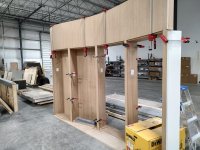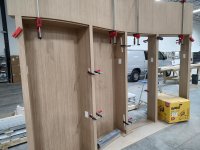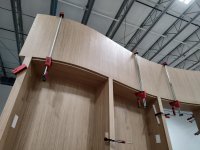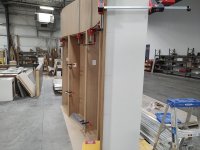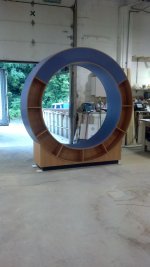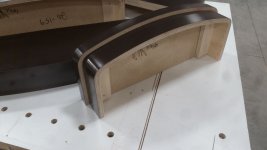- Joined
- Oct 16, 2015
- Messages
- 5,559
We are finally nearing the end of a job that was initially bid and contracted 2 years ago. Most of the items to this project have been produced in quantities of at least 8, some over 50. This one is unique in the fact that there is only one. Two of the units are missing the backs because of a shipping delay of the material. It came late in the day Friday and I did get them cut out and kerfed. There wasn't enough time to get this broken down to install them though. The whole thing fits into an alcove. I'm not entirely sure why, but most of the cabinetry on this project have these really high soffit-type caps? I assume they have high ceilings to keep the large rooms from feeling cramped? Instead of framed and drywalled soffits, they get matching units.
The white squares are the identifying stickers that come from the CNC area, when the parts are cut out. I normally don't peel them off until the final clean-up. Personally, I would rather see them have a fixed shelf in the middle, but that's not in my power.
The Dewalt saw was a handy counterweight too stabilize the unit. It's rather top-heavy and that furnace blows hard enough to make it sway slightly. The cabinets will ship separately and that cap is also in 2 pieces, as it is over 12 feet long. The styles cover the edges and will be permanently attached, in the field, with 5mm Dominos and Lamello Zeta Tenso clips. They are just sitting there with the Dominos at this point, with the cabs just clamped.
The white squares are the identifying stickers that come from the CNC area, when the parts are cut out. I normally don't peel them off until the final clean-up. Personally, I would rather see them have a fixed shelf in the middle, but that's not in my power.
The Dewalt saw was a handy counterweight too stabilize the unit. It's rather top-heavy and that furnace blows hard enough to make it sway slightly. The cabinets will ship separately and that cap is also in 2 pieces, as it is over 12 feet long. The styles cover the edges and will be permanently attached, in the field, with 5mm Dominos and Lamello Zeta Tenso clips. They are just sitting there with the Dominos at this point, with the cabs just clamped.

